How to Count in Chinese and English the Montessori Way
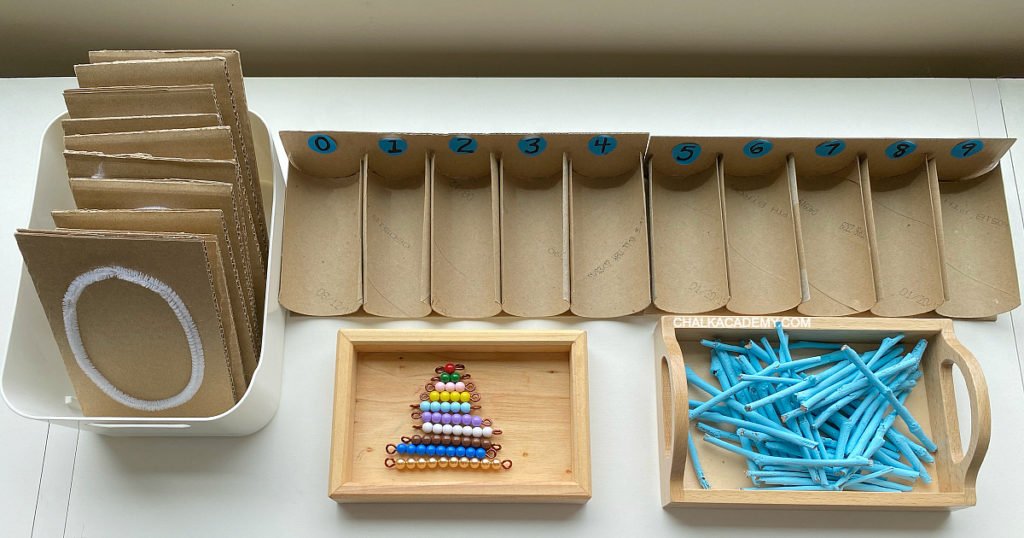
In the past year, my 3-year-old son has been learning how to count in Chinese and English. He was excited to discover that certain quantities match specific number symbols!
Chalk Academy is reader-supported. Some of the links are affiliate links. When you buy something through an affiliate link, we may earn a very small commission at no cost to you. Details here.
Although my daughter precociously picked up basic math concepts through everyday experiences, we’ve been following the systematic Montessori approach for my son.

In addition to counting his food, rock / stick collection, and favorite toys, Montessori materials have helped reinforce basic concepts.

Chalk Academy is reader-supported. Some of the links are affiliate links. When you buy something through an affiliate link, we may earn a very small commission at no cost to you. Details here.
Benefits of Montessori methods for learning how to count
Dr. Maria Montessori’s hands-on materials are unique in that they isolate specific concepts, one by one from concrete to abstract, while intentionally building connections to other concepts.
Montessori materials are like games for my son. Using them over and over solidifies important math concepts!
Setting up the materials in trays in our kids’ play area allows my son to participate in homeschooling with big sister who is 3 years older than him. When my son picks up the tray that he’s working on, this gives him a chance to be independent, develop concentration, and use gross motor and fine motor muscles!
While each material and step may not be necessary for everyone, understanding and following the general order can help establish a strong math foundation and identify challenges.

I’ll first review the order for presenting counting concepts to toddlers and preschoolers.
Since the official Montessori school materials are often pricey and large, I’ll explain which materials we opted to DIY versus purchase. I also made a few printable versions for extra busy parents!
Note: Although I have not undergone formal Montessori training, I’ve observed Montessori teachers and read about Montessori’s philosophy. If you are AMI or AMS certified, please feel free to share additional suggestions in the comments section! We’d love to learn from you!

How to use the Montessori 3-period lesson for teaching counting in Chinese and English
The way caregivers and teachers introduce and review concepts is very important regardless of the materials and resources you decide to use!
The Montessori 3-period lesson consists of 3 phases:
- Introduction of the name or concept
- This is when a caregiver or teacher demonstrates describing concepts
- For counting: 这里有一块石头。/ 這裡有一塊石頭。 (Zhèlǐ yǒu yīkuài shítou.)
- For number symbols: 这是一。 / 這是一。(Zhè shì yī. / This is one). 这个数字是三 。/ 這個數字是三。 (Zhège shùzì shì sān / That number is three.)
- This is when a caregiver or teacher demonstrates describing concepts
- Recognition of the name or concept
- This is when a caregiver or teacher will ask questions and the child may respond by pointing, touching, or picking up the word, number, or object.
- Potential questions to assess a child’s ability to recognize a concept include:
- For counting: 请给我两块石头。/ 請給我兩塊石頭。 (Qǐng gěi wǒ liǎng kuài shítou. Please give me 2 rocks.)
- For number symbols: 一在哪里?/ 一在哪裡? (Yī zài nǎlǐ? / Where is one?)
- Recall of the name or concept
- This step involves caregivers/teachers asking a child to give specific answers, or the child may just volunteer the information if they confidently know it.
- These types of questions include:
- 这里有几块石头?/ 這裡有幾塊石頭? (Zhèlǐ yǒu jǐ kuài shítou? / How many rocks are here?)
- 这是什么号码吗? / 這是什麼號碼嗎?(Zhè shì shénme hàomǎ ma? / What number is this?)
- 你能写三吗?/ 你能寫三嗎? (Nǐ néng xiě sān ma? / Can you write the number three?)
Too often, caregivers and parents may rush from the first and third period and start quizzing the child.
The child will understandably refuse to answer; pushing the child further can crush his or her confidence and interest in learning more.
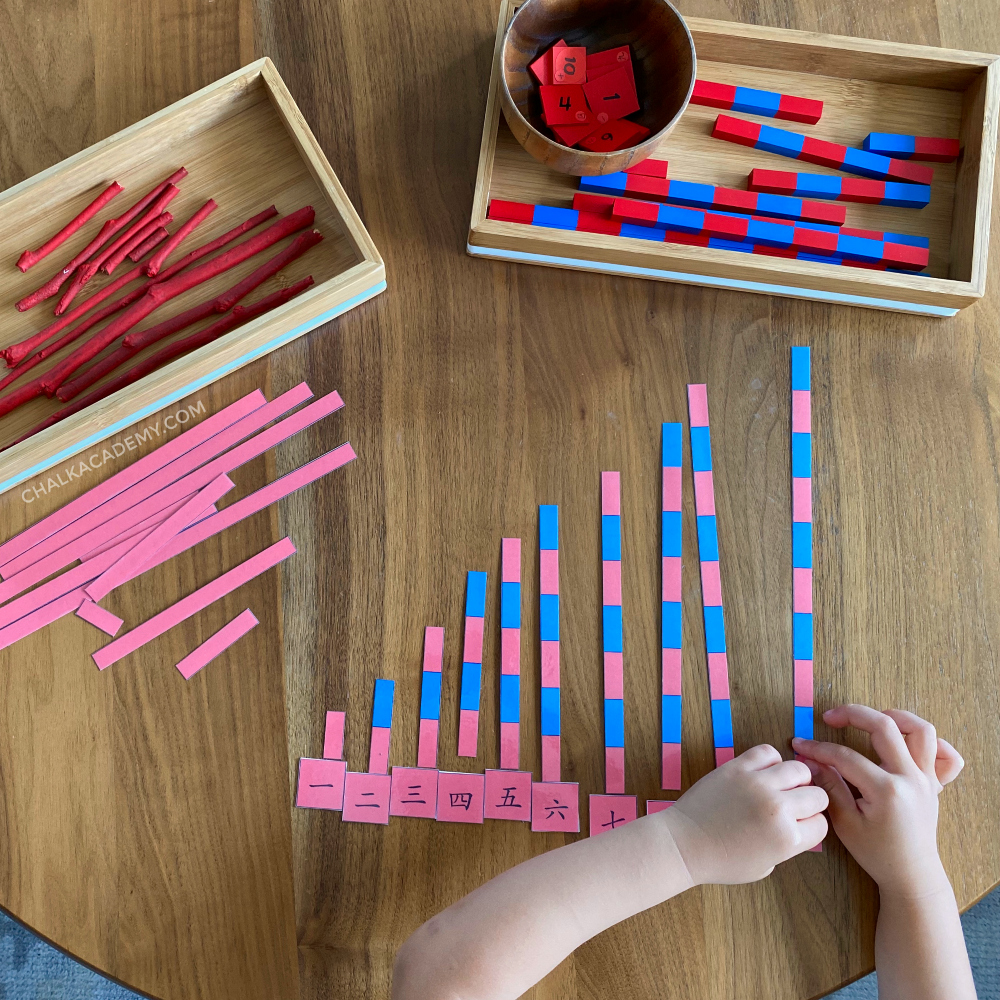
Common vocabulary: how to count to ten in Chinese and English
Since many of you are learning Chinese with your children, this is how to count in simplified Chinese, traditional Chinese, Hanyu Pinyin, and English.
How to say numbers one through ten in Chinese
- 0: 零 (líng / zero)
- 1: 一 (yī / one)
- 2: 二 (èr / two)
- 3: 三 (sān / three)
- 4: 四 (sì / four)
- 5: 五 (wǔ / five)
- 6: 六 (lìu / six)
- 7: 七 (qī / seven)
- 8: 八 (bā / eight)
- 9: 九 (jiǔ / nine)
- 10: 十 (shí / ten)
Video example of counting in Chinese
This YouTube video from Chinese for Us gives a helpful overview of how to count in Chinese.
Other important math phrases in Chinese and English
- 比较 / 比較 (bǐjiào / compare)
- 长 / 長 (cháng / long)
- 短 (duǎn / short)
- 更多 (gèng duō / more)
- 更少 (gèng shǎo / less)
Order of introducing Montessori math materials for numbers 0-10
- Long red rods 红长棒 / 紅長棒 (hóng cháng bàng)
- Number rods 数棒 / 數棒 (shù bàng)
- Sandpaper numbers 数字砂字板 / 數字砂字板 (shùzì shā zì bǎn)
- Number rods and numbers 数棒和数字 / 數棒和數字 (shù bàng he shùzì)
- Spindle box 纺锤棒:附整理盒 /. 紡錘棒:附整理盒 (fǎngchuí bàng: fù zhěnglǐ hé) and concept of zero
- Cards and counters 数字与筹码 / 數字與籌碼 (shùzì yǔ chóumǎ)
- Colored bead stair 彩色串珠阶梯 / 彩色串珠階梯 (cǎisè chuànzhū jiētī)
- Hundred chart and hundred board 百数板 / 百數板 (bǎi shù bǎn)

Long red rods 红长棒 / 紅長棒 (hóng cháng bàng)
The 10 Montessori red rods is the first math material. Through tactile and visual discrimination, the red rods focuses on the concept of length.
In the classroom, the Montessori red rods are intentionally large to create a great sensorial impression on a child. The smallest unit is 10cm; each subsequent unit is 1cm longer, and the 10th unit is 100cm.
Due to limited space and my son’s love of tree branches, we used branches cut to the same length as our mini Montessori number rods.
I’ve also created a printable version for families who are short on time!
Please review the Terms & Conditions before downloading any materials. ©2023 CHALK ACADEMY. Do not share any files without permission from chalkacademy.com. Only this website link may be shared.
How to DIY
- Hands-on
- What you need: *straight tree branches or strips of cardboard, wire cutter, ruler, red acrylic paint (optional), paint brush (optional)
- How to make this:
- Cut 10 tree branches into lengths of 1-10inches
- Paint tree branches red if time permits (not necessary if you’re busy)
- Printable version
- What you need: Printable red rods template (click here to download), cardstock paper, laminator and laminating pockets (recommended for durability)
- How to make this:
- Cut red rods and number rods
- Cut number cards; bilingual families can tape both languages back-to-back
*Look for branches or cardboard pieces that are the exact same texture and width so that the main difference is length.
If you’re more handy and crafty, check Home Depot for wood dowels or planks that you can saw and sand!
Where to buy
True-to-size Montessori red rods can be found on Amazon.
Relevant vocabulary
- Period 1: 这是一根短红棒 / 這是一根短紅棒 (Zhè shì yī gēn duǎn hóng bàng / This is a short red stick)
- Period 2: 请给我最长的棍子。/ 請給我最長的棍子。Qǐng gěi wǒ zuì cháng de gùnzi. / Please give me the longest stick).
- Period 3: 这根红长棒比另一根红长棒长还是短? (Zhè gēn mù gùn bǐ lìng yī gēnmù gùn cháng háishì duǎn? / Is this stick longer or shorter than the other stick?)
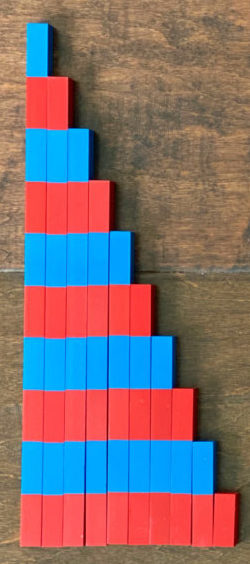
Number rods 数棒 / 數棒 (shù bàng)
Number rods are the next step in primary Montessori math. In a Montessori classroom, these rods are exactly the same size as the aforementioned red rods.
The difference is that the alternating red and blue sections represent quantity: 1 unit, 2 units, 3 units, etc.
Again, due to limited space and budget, we did not get the large classroom material. Instead, we bought a more affordable mini version that my son enjoys. Just like the long red rods, the smallest unit is 1 inch; subsequent rods increase by 1 inch increments as indicated by the colors.
My son likes to compare the lengths of his red rods, number rods, and other objects around the house!
Although the set comes with number cards as show in the above image, this is actually introduced after sandpaper numbers.
How to DIY
- Hands-on
- What you need: *straight tree branches or strips of cardboard, wire cutter, ruler, red acrylic paint (optional), paint brush (optional)
- How to make this:
- Cut 10 tree branches into lengths of 1-10inches
- Paint tree branches red if time permits (not necessary if you’re busy)
- Printable number rods
*Look for branches or cardboard pieces that are the exact same texture and width so that the main difference is length.
Where to buy
The mini number rods can be found on Amazon here.
Relevant phrases
- Period 1:
- 这个数棒有蓝色和红色 / 這個數字桿有藍色和紅色 (Zhège shù bàng yǒu lánsè hé hóngsè / This number rod has blue and red).
- 让我数一数 / 讓我數一數 (Ràng wǒ shǔ yī shǔ / Let’s count together)
- Period 2: 请给我三。/ 請給我三。 (Qǐng gěi wǒ sān. Please give me three.)
Sandpaper numbers 数字砂字板 / 數字砂字板 (shùzì shā zì bǎn)
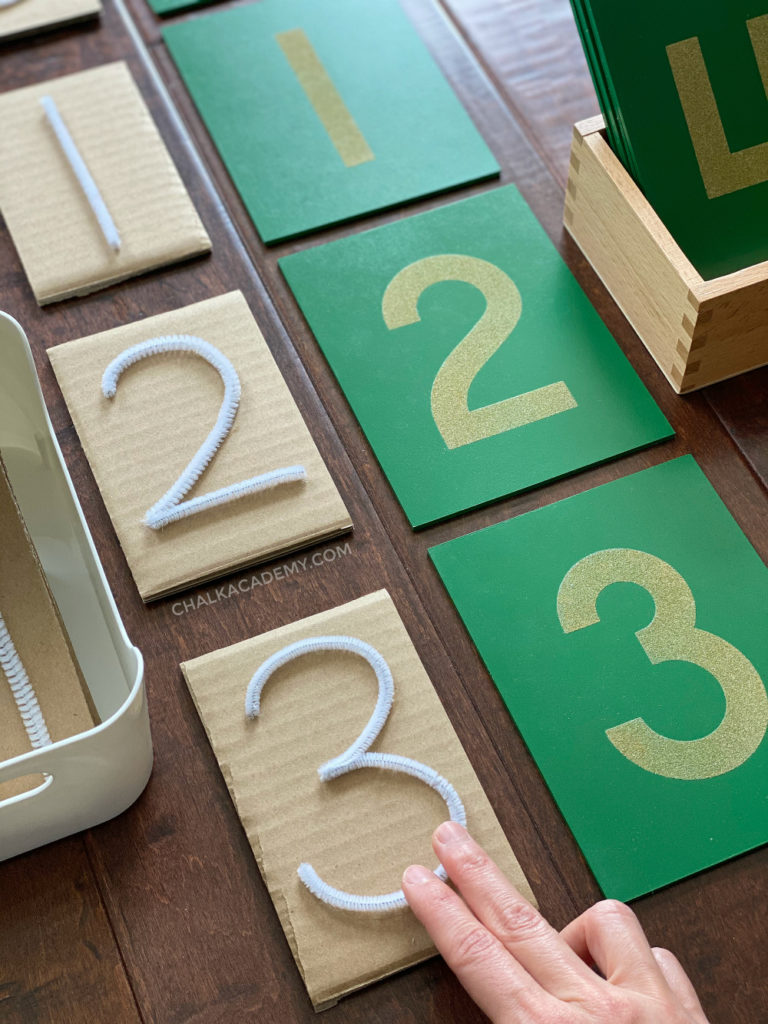
Since numbers are abundant in the environment children may learn to memorize number symbols before they understand what they represent. In contrast, per the Montessori method, the best time to introduce abstract numerical symbols is after a child has a good grasp of quantity.
Traditionally, sandpaper numbers are used to stimulate tactile receptors while memorizing Chinese characters 一二三 (yī’èrsān) and/or Arabic number symbols 123. The parent, caregiver, or teacher presents each number following the 3-period lesson. Each symbol is traced slowly with 2 fingers following correct stroke order.

Printable Chinese stroke order number cards

For those who are extra tight on time and budget, you can also try printable stroke order Chinese number cards that I made.
What you need:
- Cardstock paper, laminator and laminating pockets (recommended for durability)
- Printables: Simplified Chinese or Traditional Chinese
How to prepare:
- Pages 1-5 have dots indicating stroke order; pages 6-10 are normal Chinese numbers.
- Print double-sided so that kids can see normal character and stroke order prompts.
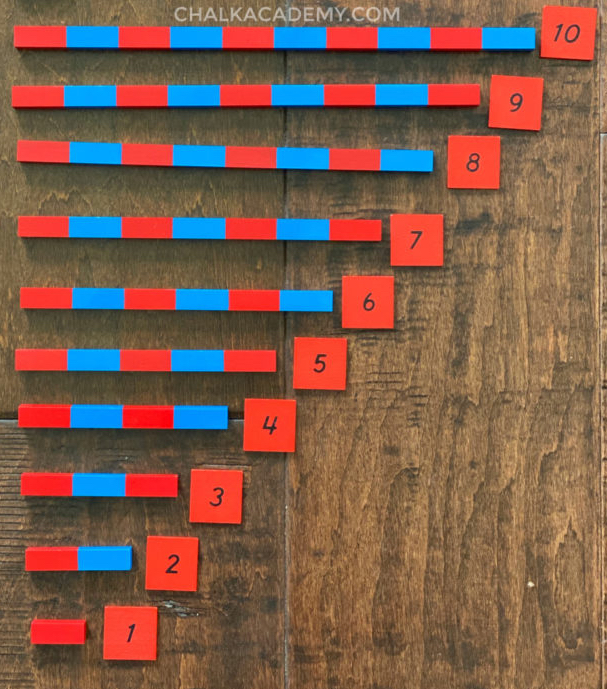
Number rods and numbers 数棒和数字 / 數棒和數字 (shù bàng he shùzì)
Now that the child recognizes number symbols from the sandpaper cards, he or she can start matching numbers with the number rods!
As with before, the counters are fixed but the numbers are loose.
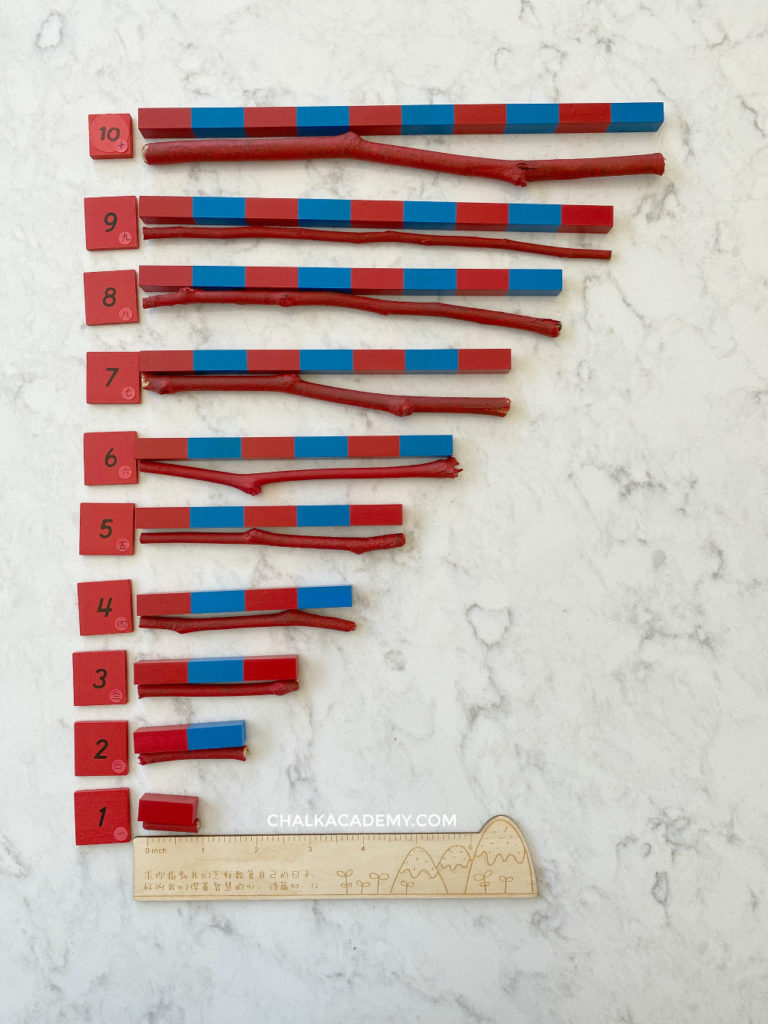
Here’s a great video demonstration of how to present The Montessori number rods and number cards.
Spindle box 纺锤棒:附整理盒 /. 紡錘棒:附整理盒 (fǎngchuí bàng: fù zhěnglǐ hé) and concept of zero
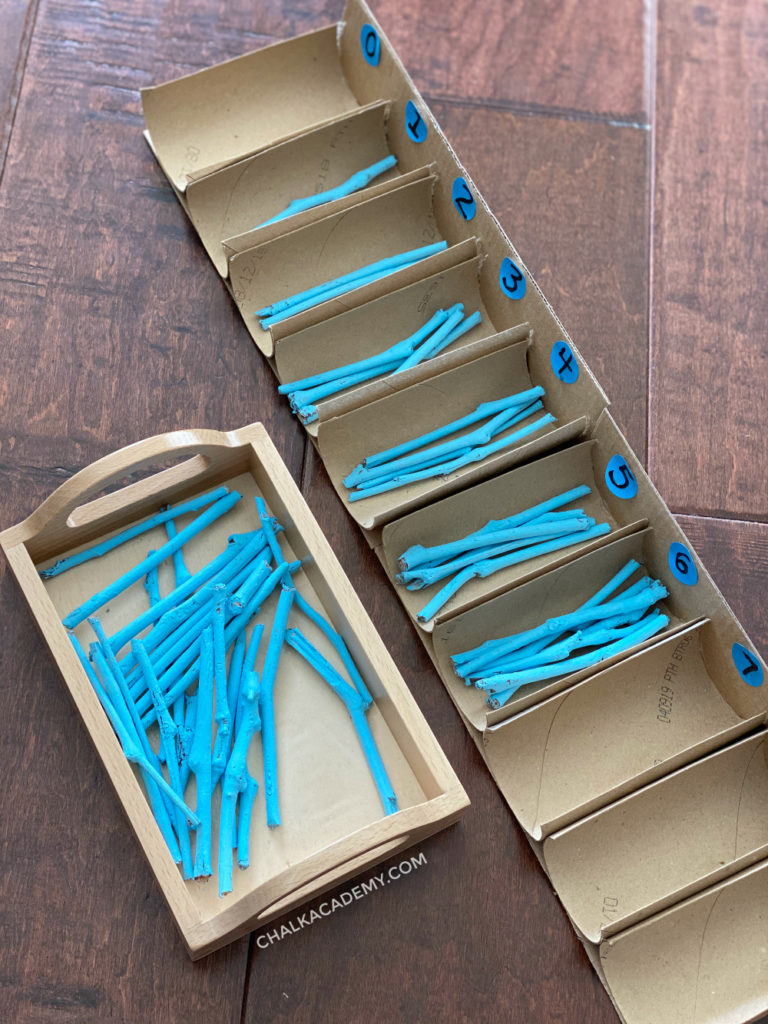
The Montessori spindle box activity reinforces the concept of zero along with counting and associating quantity with number symbols. Here, the numbers are fixed in numerical order while the counters are loose.
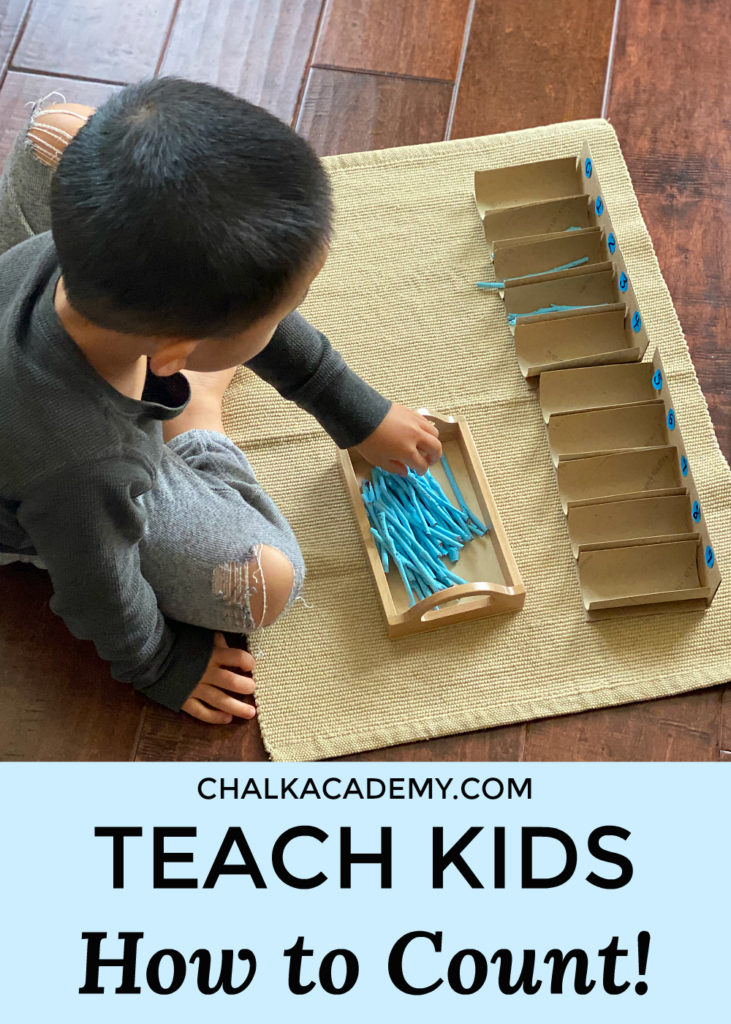
This post about our DIY Montessori Spindle Box has detailed teaching tips and instructions.
Cards and counters 数字与筹码 / 數字與籌碼 (shùzì yǔ chóumǎ)
This next step is more advanced, because the numbers and counters are both loose and not fixed.
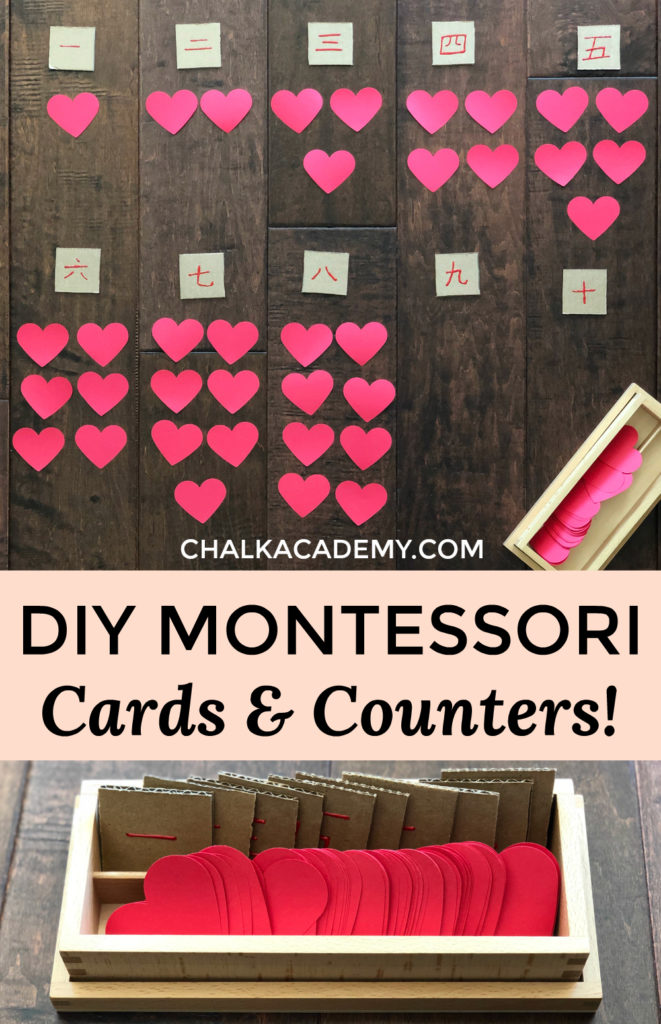
Where to buy
Amazon sells Montessori cards and counters.
How to DIY
- What you need: large 2.5″ circle punch or large heart punch, paper trimmer, red cardstock paper, cardboard, marker or puffy paint (optional)
- How to make this:
- Use large paper punch to cut out 55 red counters
- Create number cards with cardboard and marker (or puffy paint). To save time, skip this step and use the aforementioned tactile numbers.
Colored bead stair 彩色串珠阶梯 / 彩色串珠階梯 (Cǎisè chuànzhū jiētī)
This last material reinforces the above concepts and serves as an introduction to counting in the teens, addition, subtraction, and multiplication!
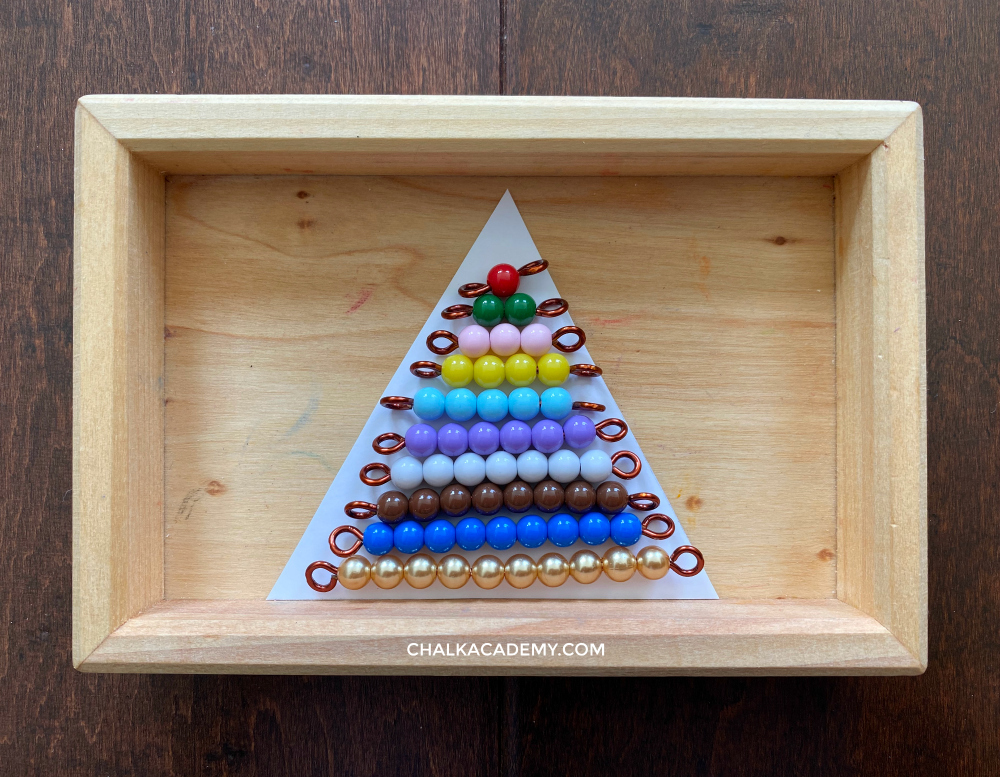
I didn’t buy any specific material for this but invested in a large set of Montessori decanomial beads.
Hundred chart and hundred board 百数板 / 百數板 (bǎi shù bǎn)
Before reaching this step, a Montessori classroom has a lot of other materials that teach how to count in the teens, but we are not sure if it’s worth getting all of them for our home.
For learning how to count to 100, we love our hundred board and printable hundred chart in English and Chinese! My daughter also used our hundred chart in Korean. Although we are not currently planning on doing math in Korean with my son, I hope your families can still benefit from the hundred chart!
Has your child tried these hands-on Montessori math activities?
If you try any of these activities, please let us know in the comments below!
Did you find them all useful, or did your child need only 1 or 2? We’d love to hear about your learning experience!
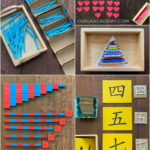

Where did you get the wood tray for the cards and counters activity? I’d love a tray with a divider like that. Thanks!
Hi! I’m not sure where that particular tray is from as I repurposed it from something else. But the dimensions are similar to this tray.